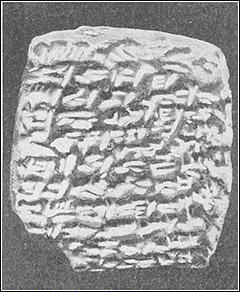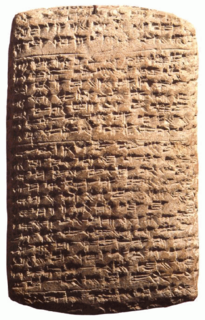Related Research Articles

The Amarna letters are an archive, written on clay tablets, primarily consisting of diplomatic correspondence between the Egyptian administration and its representatives in Canaan and Amurru, or neighboring kingdom leaders, during the New Kingdom, between c. 1360–1332 BC. The letters were found in Upper Egypt at el-Amarna, the modern name for the ancient Egyptian capital of Akhetaten, founded by pharaoh Akhenaten (1350s–1330s BC) during the Eighteenth Dynasty of Egypt. The Amarna letters are unusual in Egyptological research, because they are mostly written in a script known as Akkadian cuneiform, the writing system of ancient Mesopotamia, rather than that of ancient Egypt, and the language used has sometimes been characterised as a mixed language, Canaanite-Akkadian. The written correspondence spans a period of at most thirty years.
The Amarna Period was an era of Egyptian history during the later half of the Eighteenth Dynasty when the royal residence of the pharaoh and his queen was shifted to Akhetaten in what is now Amarna. It was marked by the reign of Amenhotep IV, who changed his name to Akhenaten in order to reflect the dramatic change of Egypt's polytheistic religion into one where the sun disc Aten was worshipped over all other gods. The Egyptian pantheon was restored under Akhenaten's successor, Tutankhamun.

Burna-Buriaš II, rendered in cuneiform as Bur-na- or Bur-ra-Bu-ri-ia-aš in royal inscriptions and letters, and meaning servant or protégé of the Lord of the lands in the Kassite language, where Buriaš is a Kassite storm god possibly corresponding to the Greek Boreas, was a king in the Kassite dynasty of Babylon, in a kingdom contemporarily called Karduniaš, ruling ca. 1359–1333 BC, where the Short and Middle chronologies have converged. Recorded as the 19th King to ascend the Kassite throne, he succeeded Kadašman-Enlil I, who was likely his father, and ruled for 27 years. He was a contemporary of the Egyptian Pharaohs Amenhotep III and Akhenaten. The proverb "the time of checking the books is the shepherds' ordeal" was attributed to him in a letter to the later king Esarhaddon from his agent Mar-Issar.

Karduniaš, also transcribed Kurduniash, Karduniash, Karaduniše, ) is a Kassite term used for the kingdom centered on Babylonia and founded by the Kassite dynasty. It is used in the 1350-1335 BC Amarna letters correspondence, and is also used frequently in Middle-Assyrian and Neo-Assyrian texts to refer to the kingdom of Babylon. The name Karaduniyaš is mainly used in the letters written between Kadashman-Enlil I, or Burna-Buriash, the Kings of Babylon, and the Pharaoh of Ancient Egypt-(called: Mizri), letters EA 1-EA 11, a subcorpus of letters,. Much later, a version of the name was used in the Babylonian Talmud as Kardunya referring to similar locations. In the Assyrian texts its referred to as Kardu.

Amarna letter EA 282 is a relatively short ovate clay tablet Amarna letter, located in the British Museum, no. 29851.

Amarna letter EA 35, titled The Hand of Nergal, is a moderate length clay tablet letter from the king of Alashiya to the king (pharaoh) of Egypt. The letter has multiple short paragraphs, with scribed, single-lines showing the paragraphing. Paragraphs I-VII are on the letter's obverse; paragraph VIII starts at the bottom edge and continues, ending at Paragraph XIII on the clay tablet's reverse.

Amarna letter EA 367, titled From the Pharaoh to a Vassal, is a medium-small, square clay tablet Amarna letter to Endaruta of Achshaph,, one of only about 10 letters of the el-Amarna corpus, that is from the Pharaoh of Egypt to his correspondent.
The Amarna letter EA1 is part of an archive of clay tablets containing the diplomatic correspondence between Egypt and other Near Eastern rulers during the reign of Pharaoh Akhenaten, his predecessor Amenhotep III and his successors. These tablets were discovered in el-Amarna and are therefore known as the Amarna letters. All of the tablets are inscribed with cuneiform writing.
Amarna Letter EA2 is the letter of the Amarna series of inscriptions designated EA2, which is inscribed with cuneiform writing showing the continuation of a correspondence between Kadašman-Enlil I and Amenḥotep III, from EA1. This letter is known to be concerning, A Proposal of Marriage. The letter is part of a series of correspondences from Babylonia to Egypt, which run from EA2 to EA4 and EA6 to EA14. EA1 and EA5 are from Egypt to Babylonia.
Amarna Letter EA3 is a letter of correspondence between Nimu'wareya, this being the ruler of Egypt, Amenḥotep III, and Kadašman-Enlil, the king of Babylon. In the Moran translation, the letter is given the cursory or synoptic title Marriage, grumblings, a palace opening. The letter is part of a series of correspondences from Babylonia to Egypt, which run from EA2 to EA4 and EA6 to EA14. EA1 and EA5 are from Egypt to Babylonia.
Amarna Letter EA4 is a continuation of correspondence between Kadašman-Enlil I and Amenhotep III.

Amarna Letter EA5, one of the Amarna letters, is a correspondence between Kadašman-Enlil I and Amenhotep III.
Amarna Letter EA6 is a correspondence from Burra-Buriyaš to Nimmuwarea the king of Egypt.
Amarna Letter EA7 is a letter of correspondence between Napḫurureya, king of Egypt, and Burra-Buriyaš the king of Karaduniyaš, and is part of a series of correspondences from Babylonia to Egypt, which run from EA2 to EA4 and EA6 to EA14. EA1 and EA5 are from Egypt to Babylonia.
Amarna Letter EA8 is a continuation of correspondence between Napḫurureya, king of Egypt, and Burra-Buriyaš the king of Karaduniyaš.

Amarna Letter EA10 is the letter of the Amarna series of diplomatic correspondence designated EA 10, which is written in cuneiform writing showing the continuation of a correspondence between Burna-Buriash II an ancient king of Babylon, and Akhenaten, an ancient pharaoh of Egypt.
Amarna letter EA12 is a correspondence written to the King of Egypt by a princess of Babylonia.

Amarna letter EA 39, titled: "Duty-Free", is a fairly short letter from the King of Alashiya. Almost half the letter, Para I, is a shortened greeting formula. The letter is requesting the Pharaoh to let messengers pass freely, as they are also being represented as merchants; this also applies to their shipping.

Amarna letter EA 158, titled: "Father and Son", is a moderate length letter from Aziru, the leader of the region of Amurru. The letter is written to the Egyptian official, Tutu/ (Dudu). EA 158 is the third letter in a series of 16 letters regarding Aziru.

Amarna letter EA 170, titled: "To Aziru in Egypt", is a moderate length letter, from Aziru, the leader of the region of Amurru. EA 170 is the fifteenth letter in a series of 16 letters regarding Aziru.
References
- 1 2 S. Najovits (2003). Egypt, the Trunk of the Tree, Vol.II: A Modern Survey of and Ancient Land (p.167). Algora Publishing, 1 Oct 2003, 268 pages. ISBN 0875862578 . Retrieved 2015-07-09.
- ↑ W.L. Moran (ed.). The Amarna Letters (PDF). Translated by W.L. Moran. Baltimore; London: Johns Hopkins University Press. Archived from the original (PDF) on 2015-07-14. Retrieved 2015-07-04.